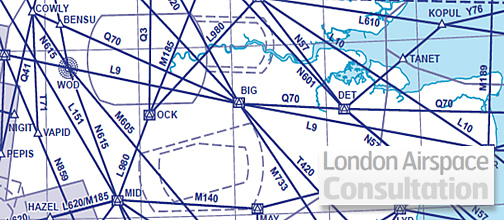Change is coming! The London Airspace Consultation
24 October 2013Air travel plays a crucial role in supporting economic growth and prosperity, particularly for an island nation like the UK. Flying is an essential part of modern life.
But despite the fact we all take it for granted that we can fly off on holiday whenever we want, we then get upset by the noise of aircraft over our homes!
The fact is that southern England is some of the busiest airspace in the world and there isn’t anywhere that isn’t already overflown. But we can make it better, and quieter for people on the ground, thanks to new technology.
The airspace above us is the invisible infrastructure in our transport system. We can’t see it or touch it but airlines and airports don’t work without it!
New European legislation requires all Member States, including the UK, to revise our airspace to incorporate new, very precise aircraft navigation capability. Changing our airspace to meet the new requirements also gives us the opportunity to modernise our airspace structures to improve efficiency, and to reduce the environmental impact of air traffic.
We are now consulting on how best to enable that change. This is the first stage in a wider programme of proposed changes to deliver the UK’s Future Airspace Policy, developed by the Civil Aviation Authority (CAA) with the support of the aviation industry.
This first stage addresses changes to the airspace supporting Gatwick Airport from ground level up, and to the airspace supporting London City above 4,000ft. Later stages will address proposals for airspace supporting other parts of the London airports network, to be complete by 2020.
We are proposing a new design concept to replace conventional holds, or stacks, to support Gatwick and London City airports. Point Merge will change the spread of flight paths across the sky, so will change the local noise and visual impact, but it is important to note that these areas are already overflown today. More information on Point Merge can be found in the infographic below.
The net effect of these proposals will be less noise – aircraft will climb higher, more quickly on departure and stay higher for longer on arrival. However, flight paths will change, some areas may be overflown more, others less and some will not notice any significant change. We include the possibility of “respite routes” – additional routes that could provide some predictable respite from noise for people living below flight paths near Gatwick.
Our new design concept, making the most of modern navigation capability, will significantly reduce the use of conventional holds (or stacks), and put new route structures over the sea where possible. This change will improve efficiency – reducing the average amount of CO2 emitted by each flight.
You can find out more information on the proposals, and how they may affect you, by visiting www.londonairspaceconsultation.co.uk. The website contains maps on today’s air traffic, the swathes within which we are seeking to design routes, and the consultation document and response form. We are asking everyone in the geographic areas identified to assume that a new route may go over them and therefore to provide us with the local information they believe we should factor into designing final route positions.
You have until 21 January 2014 to share your feedback with us.
Point Merge infographic
Comments
Please respect our commenting policy and guidelines when posting on this website.





